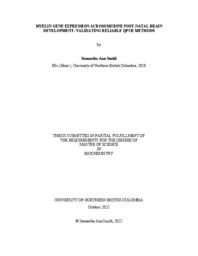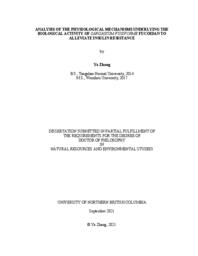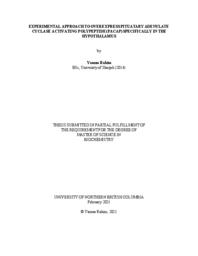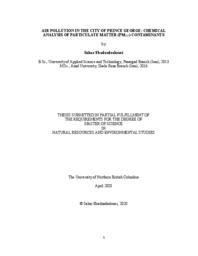Bird, Ranjana
Person Preferred Name
Ranjana Bird
Related Works
Content type
Digital Document
Description / Synopsis
Myelination is essential for proper conduction across all neural networks. Myelination in the central nervous system is performed by glial cells called oligodendrocytes. Mature, myelinating glia develop from progenitor cells through distinct differentiation steps, and gene expression markers have been established that are unique to oligodendrocyte lineage cells. This study aims to establish a reliable RT-qPCR protocol to quantify oligodendrocyte-specific gene expression according to the MIQE guidelines. Primers specific to the progenitor, immature, and myelinating stages of oligodendrocyte differentiation were validated, showing 90-100% efficiency. Reference gene primers were also validated, and their stability was determined to make recommendations for those to use as normalization factors. The expression pattern of oligodendrocyte-specific genes across stages of postnatal development was similar to previously defined RNA-seq profiles in isolated cell types. The validated RT-qPCR assays developed build a framework for future investigation on myelination during development and remyelination in disease.
Origin Information
Content type
Digital Document
Description / Synopsis
Type 2 diabetes mellitus (T2DM) is a chronic metabolic disease characterized by hyperglycemia resulting from progressive loss of β-cell insulin secretion frequently on the background of insulin resistance. T2DM, also known as non-insulin-dependent diabetes, accounts for more than 90% of all cases of diabetes. Insulin resistance (IR) refers to the reduced sensitivity of peripheral tissues to insulin and is one of the important triggers of type 2 diabetes. Sargassum fusiforme polysaccharide exhibits diverse biological activities, and more and more studies have shown it has a significant effect in improving insulin resistance with almost no side effects. Sargassum fusiforme fucoidan (SFF) is one of the main active components with active ingredients such as antioxidants and hypoglycemic lipids. However, the ameliorative effects of SFF on high-fat diet-induced insulin resistance mice and its underlying physiological mechanisms are not clear. Hence, the polysaccharides were extracted and purified from Sargassum fusiforme, and fucoidan (SFF), which has good antioxidant activity, was screened using a drosophila melanogaster aging model. The effect of SFF on the amelioration of insulin resistance in mice was investigated with a high-fat obese insulin resistance mice model. By gut microbiota and metabolomics techniques, the effect of SFF on intestinal metabolites and its mechanism of alleviate IR were investigated. After treatment with 200 mg/kg SFF for 8 weeks, it was found that SFF could reduce body weight, fasting blood glucose and homa-IR in insulin resistance mice. SFF could effectively activate Nrf2/ARE antioxidant signaling pathway in the liver and promote Nrf2 entry into the nucleus and downstream gene transcription. Metabolomics and intestinal microecology revealed that SFF could upregulate TUDCA level and downregulate ceramide level in mice colon and serum, and this change was dependent on gut microbiota. TUDCA effectively inhibits the FXR/SHP signaling pathway activated by a high-fat diet, thereby reducing the biosynthesis of enteric-derived ceramides. In addition, TUDCA in the liver could compete with Nrf2 to bind Keap1 to reduce the formation of the Nrf2/Keap1 complex, reduce Nrf2 ubiquitination, and thus contribute to Nrf2/ARE signaling activation. In conclusion, fucoidan from S. fusiforme was able to modulate gut microbiota, increased the levels of the intestinal metabolite TUDCA, reduced biosynthesis of entericderived ceramides and activated the Nrf2/ARE pathway, which in turn significantly improved insulin resistance induced by high-fat diet in mice. This study provides a new research idea for the study of brown algae fucoidan in metabolic diseases.
Origin Information
Content type
Digital Document
Description / Synopsis
Obesity is adetrimental health condition that occurs when energy intake, exceeds energy expenditure. Pituitary adenylatecyclase-activating polypeptide (PACAP) regulates energy expenditure, including adaptive thermogenesis, through the hypothalamic-sympatheticnervous system-brown adipose tissue axis. We hypothesize that PACAP expression in the ventromedial nucleus (VMN) is required for adaptive thermogenesis. To assess this, our goal is to develop an animal model that expresses PACAP specifically in the VMN of the hypothalamus. As a first step to achieving this goal, we established a protocol to deliver an adeno-associatedvirus (AAV) expressing the visible protein eGFP under the control of a VMN-specific promoter, steroidogenic factor 1 (SF1) using stereotaxic surgery. A second step was to develop a protocol to detect PACAP mRNA in the brain using in situ hybridization. Our results showed that the stereotaxic protocol was successful and provides significant progress towards achieving PACAP-specific expression in the VMN.
Origin Information
Content type
Digital Document
Description / Synopsis
Air pollution has been an ongoing issue for the City of Prince George, the largest city in northern British Columbia. This research was designed to measure the chemical composition of atmospheric Particulate Matter (PM2.5) in a Prince George neighborhood (i.e., downtown). The main objective of this research was to determine the PM2.5 chemical compositions in two distinct periods: warm and cold. Overall, 153 samples were collected from January to August 2018, using personal air samplers. The highest concentration of PM2.5 was recorded during the 2018 summer wildfires. Chemical composition of the PM2.5 air samples were studied with respect to Cadmium, Potassium, Mercury, Sodium, Lead, Chromium, Iron, Cobalt, Nickel, Manganese, Copper, Titanium, Molybdenum, Phosphorus and Sulphur, in order to evaluate potential sources of air pollutants in the city. The results of this study were compared with PM2.5 averages from other Canadian and international cities. The possibilities of the contribution of some local industrial sources such as pulp and paper, biomass burning, transportation and road dust, on PM2.5 concentration and chemical composition were discussed.
Origin Information




